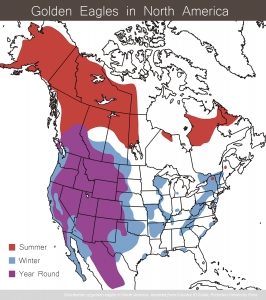Questions about the Trio that nests on the Upper Mississippi River National Wildlife and Fish Refuge, near Fulton, IL.
- What are the sexes of the trio?
The trio consists of two males and a female.
- Do both males mate with her?
Yes, we were able to capture footage that shows both copulating with her. A question many people ask is, if we know who which one is the father is to an eaglet. No, unless we can do a DNA test, that question will never be answered.
- How many eggs does she lay?
She laid 2 eggs on her first nesting attempt in 2018. 2019, 3 eggs were laid.
- Do they all share in the parental duties?
Yes, they all take part in nest maintenance, incubation and raising the young.
- How can I tell them apart?
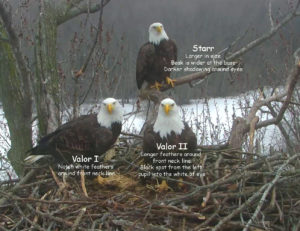
- How long have they been together?
The new trio have been together since the fall of 2017. The original trio was together since 2013. Valor I was replaced with Valor II, but Valor I did not leave. He hung around from a distance during that year. 2014, Valor I was seen hanging around but not a part of the nesting. They were seen together in 2015. It wasn’t until 2016 that we were able to document the cooperative nesting that was going on. In March of 2017, original female (Hope) did not return to the nest after a vicious battle with another eagle. Starr arrived to the nest in September 2017.
- Will they mate for life?
We can only assume that they will since the original trio was together for many years.
- What is the time frame between eggs that are laid?
For this nest, it is generally 3 days.
*General Bald Eagle information was taken from the National Eagle Center
- Where do eagles live?
Bald eagles are found across North America and typically near lakes and rivers.
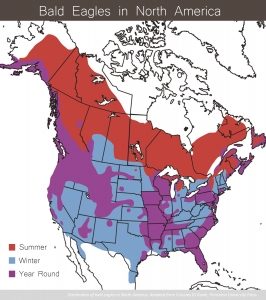
- What do Bald Eagles look like
Adult bald eagles have dark brown feathers on their body and wings, and white feathers on their head and tail. The adult’s beak and feet are yellow.
Juvenile bald eagles in their first year of life are dark brown over their body wings, head and tail. Their beak and eyes are dark. As they age, juveniles may show white feathers anywhere on the body, especially the breast and under the wings. At three to four years of age they begin to develop the white head and tail of the adult. Their beak and eyes lighten in color as they reach adulthood. A complete white head and tail usually takes until age five to develop.
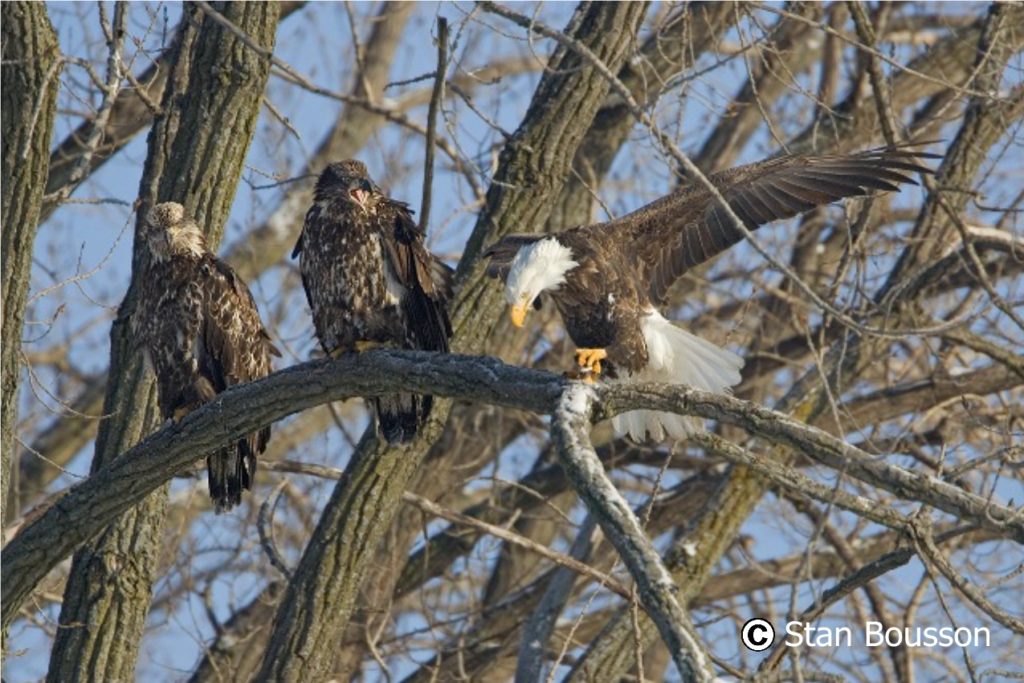
Left: 3.5 years old
Center: 2 years old
Right: 5+ years old (approximate)
- Is a bald eagle really bald?
No, bald eagles have feathers covering their heads. The name comes from the old English word “balde” which originally meant white.
- How long do eagles live:
In the wild, 70-80% of eagles die before they reach adulthood at five years of age. An eagle that makes it to adulthood might live 20-25 years. In captivity, eagles are known to live much longer, 40+ and up to 50 years, due to a controlled environment, nutrient rich diet and veterinary care.
- How far can an eagle see?
Eagles use both monocular and binocular vision, meaning they can use their eyes independently or together depending on what they are looking at.
An eagle eye has two focal points (called “fovea” [singular] or “foveae” [plural]) one of which looks forward and the other to the side at about a 45 degree angle. These two foveae allow eagles to see straight ahead and to the side simultaneously. The fovea at 45 degrees is used to view things at long distances. An eagle can see something the size of a rabbit running at three miles away.
- What is an eagle’s wingspan?
The average wingspan ranges from 6 to 7.5 feet (182cm-229cm).
Wingspan of an eagle depends on overall size. Eagles in northern parts of their range tend to be larger overall, including a larger wingspan.
- How fast can eagles fly?
Eagles can achieve 30 mph using powerful wing-beats and even faster when diving after prey (stoop). Bald eagles can dive at up to 100 mph; golden eagles at up to 150 mph.
- What does a bald eagle eat?
Fish is the primary food of bald eagles, but they will eat a variety of other animals and birds. Their prey items include waterfowl and small mammals like squirrels, prairie dogs, raccoons and rabbits. Bald eagles are opportunistic predators meaning that in addition to hunting for live prey, they will steal from other animals (primarily from other eagles or smaller fish eating birds) or scavenge on carrion.
- How much can an eagle eat at one time?
The average eagle needs between ½ and 1 pound of food each day. However, eagles do not need to eat daily. Because food sources may not be available daily, an eagle can gorge on food when it is available and hold up to 2 pounds of food in their crop.
- How large is an eagle’s stomach?
An eagle’s stomach is quite small, about the size of a walnut. However, eagles can eat up to 1/3 of their own body weight in food. They have an area called the crop to store food, allowing them to survive without finding food every day.
- How much does a bald eagle weigh?
Weight varies depending on latitude and gender. Generally, males weigh approximately 25% less than females from the same area. The average weight of a female bald eagle is 10-14 pounds; however there exists great variation depending on where an eagle is from. Southern bald eagles tend to be smaller than those in northern parts of their range. For example in Alaska, females might weigh up to 18 pounds, whereas eagles in Florida can weigh as little as 6-8 pounds. This difference in size between males and females is referred to as reverse sexual dimorphism.
- Who builds the nest?
Male and female eagles build the nest together. Both eagles will bring sticks to add to the nest structure and arrange them within the nest. The nest building activity is part of their pair bonding.
- How big is an eagle’s nest?
The average bald eagle nest is 4 to 5 feet in diameter and 2 to 4 feet deep. Each year the adult pair will add 1-2 feet of new material to the nest. The largest recorded bald eagle nest, located in St. Petersburg, Florida, was 9.5 feet in diameter, 20 feet deep and weighed almost 3 tons. Golden eagle nests, while large, are generally smaller and flatter than bald eagle nests.
- When do eagles build the nest?
Nest building may begin 1-3 months prior to mating and is considered part of the breeding process. Breeding season varies regionally, beginning in November and December in southern areas. Eagles in Illinois typically begin nest building in November/December and may lay eggs as early as late January/mid-February.
- Do eagles use the same nest every year?
Eagles have strong nest site fidelity, meaning they return to the same nest and nesting territory each year. If they successfully produce young at a nest, they are likely to return to that nest year after year. A pair might choose to build a new nest in a different area if their previous nest was unproductive (failed to fledge eaglets) or otherwise proved unsuitable.
- Do eagles have more than one nest at a time?
Some bald eagles will have a second nest in their territory. They may use one nest for a few years and then move to the second nest for a period of time.
- Do bald eagles defend territories around their nests?
Yes. The size of the territory defended depends on location and the abundance of food in that area. In an area with abundant food resources, a territory might be quite small, with other eagles’ nests as close as one mile away. Bald eagles will vigorously defend their territories from intrusion by other eagles, particularly during nesting season.
- When do bald eagles lay their eggs?
Breeding season varies by latitude. In Florida, egg laying may begin in November whereas in Alaska, egg laying typically occurs in late April through May. In Illinois, the breeding season typically runs from late January to March.
- What is the courtship process?
Eagles engage in dramatic courtship displays that involving swooping flight, aerial stick exchanges and cartwheeling. These behaviors are all part of courtship and pair bonding. Many of these behaviors also test the strength and agility of the potential mate.
- Do eagles mate for life?
Generally, yes. Eagles engage in significant courtship and pair bonding behavior. Once a pair has succeeded in breeding, the pair will likely remain together for many years. However, if a mate dies or does not return to the nesting site for the breeding season, studies show that the surviving eagle generally will find a new mate very quickly. The remaining mate will likely use the existing nest with a new mate because of eagles’ strong nest site fidelity.
- How do they mate?
While courtship displays take place in flight, eagles do not mate in the air. Rather, copulation occurs on a branch or in the nest with the male mounting the female. During copulation, the cloaca of the male and female touch and sperm is transferred form the male to the female in what is known as the cloacal kiss. Copulation may occur several times a day over a period of days.
- How long after mating does the female lay her eggs?
Approximately 5-10 days after a successful copulation.
- What color and size are bald eagle eggs?
Bald eagle eggs are off-white in color and average about 3 inches long by 2 inches wide. The average weight is 4-4.5 oz.
- How many broods does an eagle have each year?
One brood each year although in southern areas there have been reports of a second brood (a replacement clutch) if the first clutch is lost during incubation.
- How long before they hatch?
Incubation for bald eagles is about 35 days. It can take a day for the hatchling to completely break free of the egg after pipping (cracking the egg). Eggs hatch in the order in which they were laid.
- How long until the eaglets fledge?
Bald eagles fledge at about 10-14 weeks. Prior to their first flight, nestlings will flap their wings in the nest or while jumping to an adjacent branch in behavior known as branching.
- Who incubates the egg?
After it is laid, the egg must be constantly kept warm, or incubated, and protected from predators. Both males and females share incubation responsibilities but the female typically spends more time on the nest than the male. Males leave the nest to hunt, often providing food for the female. However, the female will sometimes leave the nest to hunt for herself, at which times the male will be called upon to remain at the nest.
- How do eagles keep the eggs and young eaglets warm?
The body heat of the parent keeps the developing egg warm. Like most birds, eagles develop a brood patch, or bare spot on their belly, to better facilitate heat transfer to the egg during incubation. Both male and female eagles develop a brood patch.
- Are juvenile bald eagles larger than their parents?
No, however they can appear larger in the first year because of longer flight feathers which aid the fledgling as they are learning to fly. After the first molt, the wing feathers will be the same size as an adult’s.
- When do eagles fledge?
Bald eagle young are generally ready to fledge, or take their first flight, by 10-14 weeks of age.
- How do you tell the age of an eagle?
In the first five years of life an eagle’s age can be determined by its plumage. Juvenile eagles go through five distinct annual color morphs. Once an eagle achieves maturity, their plumage remains the same throughout their life, and there is no visual clue to determine the eagle’s age.
- Will the juveniles return to the nest?
Studies show that juveniles are generally nomadic in the first four years of their life and can cover extensive geographic areas. The studies also show that when the juveniles are ready to mate, they tend to return to the general area where they were born. If a juvenile attempted to return to its birth nest, the adult pair would drive them away as they would any intruding eagle.
- Who can have eagle feathers?
Eagle feathers, and any part of an eagle, are federally protected. Only individuals and organizations with a permit from the United States Government can legally possess any part of an eagle. Enrolled members of Native American tribes can apply for a permit to receive feathers from the US Fish and Wildlife Service’s National Eagle Repository in Colorado.
- Are eagles protected by law?
Bald and golden eagles are protected under the Bald and Golden Eagle Protection Act, passed by Congress in 1940. The Act prohibits the taking or possession of any bald or golden eagle, alive or dead, including any part, nest, or egg, unless allowed by permit. “Take” includes pursue, shoot, shoot at, poison, wound, kill, capture, trap, collect, molest or disturb.
Eagles are also protected by the federal Migratory Bird Treaty Act of 1918, which protects more than 800 species of birds in North America. Feathers and parts of all migratory birds are protected and are illegal to possess without a permit. The federal Lacey Act also prohibits trade in wildlife, fish and plants that have been illegally taken, from being transported or sold and protects eagles and eagle parts from sale.
- Are bald eagles an endangered species?
Bald eagles were removed from the Federal Endangered Species list on June 28, 2007. However, they are still protected under Bald and Golden Eagle Protection Act and other federal laws.
- How can eagles stand on ice without freezing their feet?
Birds are warm-blooded, so they rely on warm blood circulating around the body. While the rest of their body is covered in feathers (think how warm down is!), their feet and legs are most often bare.
Bald eagles and other cold weather birds have special circulation in their feet and legs that allow them to withstand very cold temperatures. A complex set of arteries and veins in the leg ensure that most of the heat is ‘exchanged’, before it reaches the exposed legs and feet. This counter-current heat exchange helps to ensure that a minimal amount of heat is lost through blood flowing to the legs and feet.
Bird legs and feet also have little soft tissue, so they don’t require as much warm blood flow. When they need a quick warm up, they can tuck one foot up against their body, underneath all those warm down feathers – a great way to warm up the toes!
- Do eagles migrate?
Some eagles migrate. Eagle migration is generally connected to food sources. If an eagle’s breeding territory has ample food sources through the winter, the eagle is less likely to migrate. However, if an eagle’s breeding territory is in northern states where lakes and streams freeze or prey animals hibernate, the eagle will migrate south to find open water and food.
- What are the leading causes of eagle mortality?
Eaglets in the nest may die from falls, starvation or siblicide. About 50% of eaglets will not reach one year of age. Once fledged, many eagles die from impact injuries, starvation, disease, shooting, poisoning and electrocution. Lead poisoning is a common cause of injury and is most often fatal. The Raptor Center of the University of Minnesota has found that about 25-28% of eagles admitted for rehabilitation in the last forty years have lead in their system.
- What is the mortality rate of eagles?
About 50% of the eaglets die in their first year. Another 20-30% die before they reach adulthood at five years of age.
- Can eagles swim?
Bald eagles do not dive into the water but rather skim across the top catching fish near the surface. During salmon runs in Alaska, bald eagles have been observed standing on the shoreline and pouncing on salmon as the fish swims into shallow water. If a bald eagle catches a fish that is too heavy to lift, it may grasp the fish with its talons and use its wings like oars to swim to shore.
- Is it true that eagles go through a renewal process where they tear out all their feathers, lose their beak and talons and then grow new ones so they can live longer?
No. This is a myth that has circulated for centuries. While no one knows its origins, this myth may be derived from a biblical metaphor. An eagle would die if it plucked all its feathers and could not survive for more than a few days without food.
- How far can an eagle fly in one day?
Eagles monitored with tracking devices have been known to fly 50-125 miles in a day during migration depending on the weather conditions and wind currents.
- Do bald eagle pairs migrate together?
There is data to suggest that pairs may not migrate together. Rather, each will return to the nest and territory that they have used successfully in previous years. Generally juvenile bald and golden eagles migrate prior to the adults departing.
- Why were eagles endangered?
Eagles have faced difficulties for many reasons in the course of human history. When Europeans settled in North America, eagles were hunted sometimes for food but often as a perceived threat to livestock and competition for wild game.
In the 1950’s a chemical known as DDT (dichlorodiphenyltrichloroethane) was introduced as a widespread insecticide. In 1962, biologist Rachel Carson detailed the impacts of the indiscriminate spraying of DDT and other chemicals on wildlife, and birds in particular in her book Silent Spring. Subsequent research showed that DDT, (the chemical by-product of which was present in many aquatic environments, especially those near agricultural areas) interfered with the calcium processing of birds and resulted in deformed eggshells. Bald eagles, who feed primarily on fish, often received concentrated doses through a process called bio-accumulation. Because bald eagles breed only once per year, and have a low reproductive rate, the bald eagle population declined steeply throughout the 1960’s and 1970’s.
In 1972, DDT was banned in the United States and the bald eagle was put on the newly created Endangered Species List. Habitat conservation and reintroduction efforts helped ensure the successful recovery of the bald eagle and it was removed from the Endangered Species List in 2007.
- How many feathers does an eagle have?
An eagle has over 7,000 feathers.
- How much can an eagle carry?
A bald eagle can carry about 1/3 its body weight. Eagles are powerful predators that can catch and kill prey many times their own size. However, they are unable to fly carrying more than just a few pounds.
- What happens if an eagle nest is damaged in a storm?
The same pair of eagles have likely used that nest for several years. It is always unfortunate to see a nest destroyed because it represents a great deal of time and effort for those eagles. They are very invested in the space, adding new materials each year as they prepare to raise young.
However, it is not always a total loss for the pair if a nest is damaged. Eagles are not actively using their nests throughout the year. Eagles do not sleep in the nest – they perch on branches at night. The only time eagles are actively in the nest in when they are raising young.
In Illinois, bald eagles are on the nest February through June. Storms during that period are much more dangerous for an eagle family, and young are sometimes lost when a nest is damaged before they have fledged. But, once the young have fledged, or left the nest, the adults do not use the nest. Both juvenile and adult eagles are spending time hunting and learning to hunt.
The other good news is that the adult pair is very likely to rebuild the nest close by. If the same tree has any viable portion remaining, they may rebuild there. If not, they are likely to choose a place fairly close by. The nest represents a territory to which they are very attached, and have worked hard to defend. They will look for another suitable location within the territory so they can continue to rear young in the area that they know and has been successful in the past.
- What do golden eagles look like:
Golden eagles have dark brown feathers over their entire body, with golden feathers on the nape, or back of the neck. The beak is tri-colored; black at the tip, grayish-blue in the mid-section and yellow at the base. Their legs are feathered to the toes.
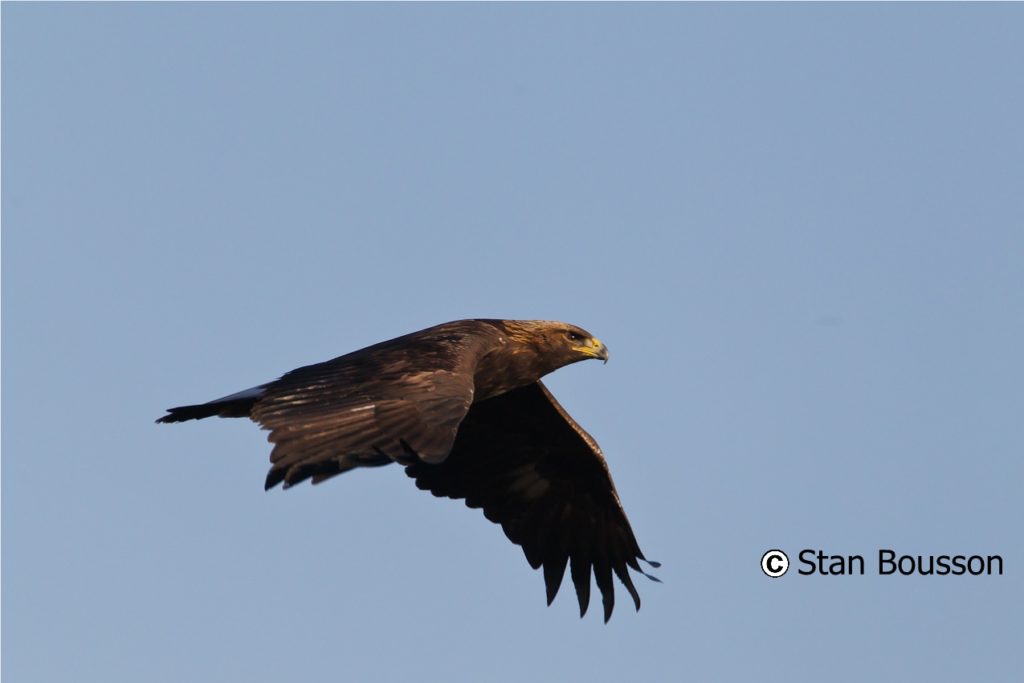
Juvenile golden eagles have distinct white patches near the wrist on the underside of the wing and a wide white band in the tail.
- How much does a golden eagle weigh?
Golden eagles weigh between 6-15 lbs (3-7 kg). Weight varies depending on latitude and gender. Generally, males weigh approximately 25% less than females from the same area. The average weight of a female golden eagle is 10-14 pounds, however there exists great variation depending on where an eagle is from. This difference in size between males and females is referred to as reverse sexual dimorphism.
- Where do golden eagles live?
Golden eagles have a worldwide distribution and are found across the northern hemisphere in Europe, Asia, North Africa and North America.
Golden eagles in North America are primarily found in the Western States and Provinces from Mexico through Alaska. There are also small breeding populations in northern Ontario and Quebec, with a wintering population in the eastern United States. Golden eagles are regular winter inhabitants in the Midwestern United States in the bluff lands of southeast Minnesota, western Wisconsin and northeast Iowa, the Driftless region.
